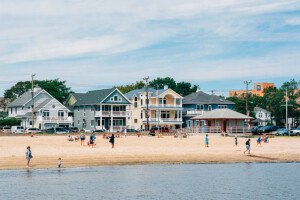Neighbors Weigh In on American Street’s Future

This illustration shows what a typical block with a bioswale in part of its median would look like. | Image from Gilmore & Associates for the City of Philadelphia
As Philadelphia went through its industrial revolution that made it “The Workshop of the World,” one of its greatest industrial districts was the one that arose along American Street in Kensington thanks to a Reading Railroad branch line.
Most of that industry is now gone, and what remains is on a much smaller scale. But the street remains huge — and foreboding to some, thanks to its desolate appearance, a byproduct of that deindustrialization. This has led to an unusual partnership between three city agencies aimed at both remaking the street for a mixed-use future and turning it into a showcase for green infrastructure.
At a public open house on July 26, representatives of the Streets Department, the Water Department and the City Planning Commission invited residents of South Kensington (Old Kensington), West Kensington and Norris Square to give their opinions about what issues the city should address first when rebuilding the street.
This much is going to happen: The remnants of the old Reading branch line will disappear. In their place will be medians with swales that are designed to serve as sponges that will soak up rainwater and release it slowly into the ground when heavy storms strike. The street will also be designed to accommodate not only car and truck traffic, including deliveries to the industrial businesses still located on it, but also bicycles and pedestrians. The redesigned street will be easier for pedestrians to cross and offer more comfortable places for riders of the Route 57 bus to wait.
“The street is underutilized and uninviting, but there’s a lot of real estate to work with,” said Streets Department Chief Engineer and President of the Board of Surveyors Darin Gatti.
Besides adding to the city’s stock of green stormwater management infrastructure, the American Street redesign seeks to enable the street to better serve all who use it now and may use it in the future: residents, travelers, store owners and manufacturers.
“This is the next generation of complete streets,” said Ariel Ben-Amos, manager of the Philadelphia Water Department’s Green Infrastructure Transportation Partnerships program. “We’re not just supporting bicycles and pedestrians, we’re supporting businesses.”
Which is why both Gatti and Ben-Amos stressed that the plans and the feedback sessions are neutral with respect to preferred uses. Although most of the industry has departed, the zoning along American Street through Kensington remains industrial for its entire length, even though there are other uses already on the street. As the question of whether the street should be preserved for industrial use as much as possible or given over to a more residential and commercial future remains somewhat contentious, the plans are being drawn up so as not to actively discourage any potential use of the street.
But the street will look dramatically different regardless what pops up along it. The prototype designs on display at the workshop, one of which appears above, envision a street with one mixed traffic lane in each direction, a dedicated bicycle lane, angle parking and a swale median that occupies either all or part of the block.
The design is also supposed to make it easier and more comfortable for pedestrians crossing the street.
Gatti said that the feedback from neighbors at both this forum and one that took place near the corridor’s northern end two weeks ago has been supportive: “They’ve been great in both giving us positive feedback and in telling us what they like about American Street [now] and what they don’t.”
Most of the suggestions for improvements participants in the July 26 open house made had to do with lighting, pedestrian amenities and managing traffic along the street. One frequently made suggestion called for replacing the highway-style lighting now found on the street with pedestrian-scaled fixtures. At least one commenter worried that only one lane for cars and trucks in each direction would cause congestion. And there were some virtual conversations about what form the parking should take: while some supported angle parking as friendlier for the commercial establishments, others expressed an interest in parallel parking that could also act as a buffer for the bike lanes.
Gatti said that the comments received at the two workshops would be compiled and assessed by City Planning Commission staff. After evaluating general community sentiment based on the comments received, the Water and Streets departments will prepare a final draft plan sometime in November and take it back out to the residents for further dialogue and refinement.
The American Street improvement project is being fast-tracked thanks to a TIGER grant from the U.S. Department of Transportation.
Follow Sandy Smith on Twitter.


